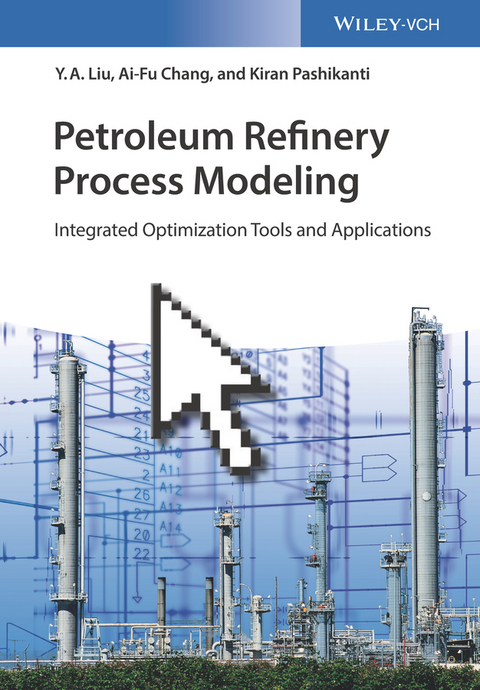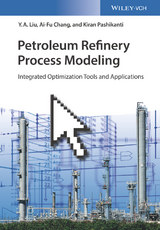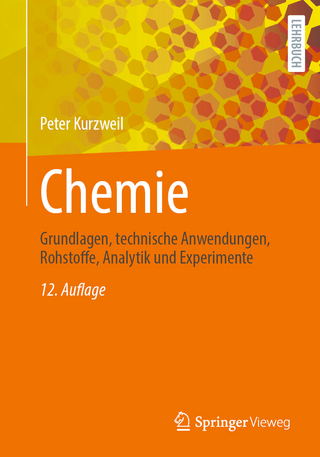Petroleum Refinery Process Modeling
Wiley-VCH (Verlag)
978-3-527-34423-9 (ISBN)
Y.A. Liu, the Alumni Distinguised Professor and the Frank C. Vilbrandt Endowed Professor of Chemical Engineering at Virginia Tech, received his B.S. (1967), M.S. (1970), and Ph.D. (1974) degrees from National Taiwan University, Tufts University and Princeton University, respectively. Professor Liu devoted his school breaks helping petrochemical industries in developing countries and chemical industries in Virginia with technology development and engineering training. He has taught intensive training courses on computer-aided design, advanced process control, energy and water savings, and refinery and polymerization process modeling to over 7,000 practicing engineers in China, Taiwan and United States. Ai-Fu Chang received his Ph.D. in the Department of Chemical Engineering at Virginia Polytechnic Institute and State University (Virginia Tech) in September, 2011. He received his B.S. in chemical engineering from National Taiwan University in 2001. He completed his doctoral dissertation on integrated process modeling and product design of biodiesel manufacturing, and refinery reaction and fraction systems. The latter was the basis of this textbook. He has worked on several industrial modeling projects, including poly (acrylonitrile-vinyl acetate), hydrocracking, and biodiesel. These projects were collaborative efforts between Virginia Tech, Aspen Technology, and industrial manufacturers. He is currently employed by Chevron Phillips Chemical Company. Kiran Pashikanti was a PhD student in the Department of Chemical Engineering at Virginia Tech. He received his B.S. in chemical engineering from Virginia Commonwealth University in 2005, and his Ph.D. in chemical engineering from Virginia Tech in September, 2011. He has worked on several industrial modeling projects on integrated modeling of refinery reaction and fraction systems, and of carbon-dioxide capture processes. This textbook grows out of his doctoral dissertation on the predictive modeling of fluid catalytic cracking (FCC) and catalytic reforming processes. He is currently employed by Chevron Phillips Chemical Company.
CHARACTERIZATION, AND PHYSICAL AND THERMODYNAMIC PROPERTIES OF OIL FRACTIONS
Crude Assay
Boiling Point Based Pseudocomponent Generation
Workshop 1.1 Interconvert Distillation Curves
Workshop 1.2 - Extrapolate an Incomplete Distillation Curve
Workshop 1.3 - Calculate MeABP of a Given Assay
Workshop 1.4 - Represent an Oil Fraction by the Old Oil Manager in Aspen HYSYS Petroleum Refining
Workshop 1.5 - Represent an Oil Fraction by the New Petroleum Assay Manager in Aspen HYSYS Petroleum Refining
Workshop 1.6 - Conversion from the Oil Manager to Petroleum Assay Manager, and Improvements of the Petroleum Assay Manager over the Oil Manager
Property Requirements for Refinery Process Models
Physical Properties
Process Thermodynamics
Miscellaneous Physical Properties for Refinery Modeling
Conclusions
Nomenclature
References
Further Reading (to add articles)
ATMOSPHERIC OR CRUDE DISTILLATION UNIT (CDU)
Introduction
Scope of the Chapter
Process Overview
Model Development
Feed Characterization
Data Requirements and Validation
A Representative Atmospheric Distillation Unit
Building the Model in Aspen HYSYS Petroleum Refining
Results
Model Applications to Process Optimization
Workshop 2.1 - Rebuild Model Using ?Backblending? Procedure
Workshop 2.2 - Investigate Changes in Product Profiles with New Product Demands
Workshop 2.3 - Investigate the Effects of Process Variables on Product Qualities
Conclusions
Nomenclature
References
Further Reading (to add articles)
VACUUM DISTILLATION UNIT
Process Description.
Data Reconciliation
Model Implementation
Model Application - VDU Deep-cut Operation.
Workshop - Using Aspen HYSYS Petroleum Refining to Implement Deep-Cut Operation.
References
Further Reading (to add references)
PREDICTIVE MODELING OF THE FLUID CATALYTIC CRACKING (FCC) PROCESS
Introduction
Process Description
Process Chemistry
Literature Review
Aspen HYSYS Petroleum Refining FCC Model
Calibrating the Aspen HYSYS Petroleum Refining FCC Model
Fractionation
Mapping Feed Information to Kinetic Lumps
Overall Modeling Strategy
Results
Applications
Refinery Planning
Workshop 4.1. Guide for Modeling FCC Units in Aspen HYSYS Petroleum Refining
Workshop 4.2. Calibrating Basic FCC Models
Workshop 4.3. Build the Model for Main Fractionator and Gas Plant System
Workshop 4.4. Perform Case Study to Identify Different Gasoline Production Scenarios
Workshop 4.5. Generate DELTA-BASE Vectors for Linear-Programming (LP)-Based Planning
Conclusions
Nomenclature
References
Further Reading (to add articles)
PREDICTIVE MODELING OF THE CONTINUOUS CATALYST REGENERATION (CCR) REFORMING PROCESS
Introduction
Process Chemistry
Literature Review
Aspen HYSYS Petroleum Refining Catalytic Reformer Model
Thermophysical Properties
Fractionation System
Feed Characterization
Model Implementation
Overall Modeling Strategy
Results
Applications
Refinery Planning
Workshop 5.1. Guide for Modeling CCR Units in Aspen HYSYS Petroleum Refining
Workshop 5.2. Model Calibration
Workshop 5.3. Build a Downstream Fractionation Error! Bookmark not defined
Workshop 5.4. Case Study to Vary RON and Product Distribution Profile
Conclusions
Nomenclature
References
PREDICTIVE MODELING OF THE HYDROPROCESSING UNITS
Introduction
Aspen Petroleum Refining HCR Modeling Tools
Process Description
Model Development
Modeling Results of MP HCR Process
Modeling Results of HP HCR Process
Model Applications - Simulation Experiments
Model Application - Delta-Base Vector Generation
Conclusion
Workshop 6.1 - Build a Preliminary Reactor Model of HCR Process
Workshop 6.2 - Calibrate Preliminary Reactor Model to Match Plant Data
Workshop 6.3 - Simulation Experiment
Workshop 6.4 - Connect Reactor Model to Fractionator Simulation
Nomenclature
References
ALKYLATION, DELAYED COKING, AND REFINERY-WIDE SIMULATION AND PRODUCTION PLANNING
Alkylation
Delayed Coking
Refinery-Wide Simulation and Refinery Margin Analysis
| Erscheinungsdatum | 18.04.2018 |
|---|---|
| Sprache | englisch |
| Maße | 170 x 244 mm |
| Gewicht | 1294 g |
| Themenwelt | Naturwissenschaften ► Chemie ► Technische Chemie |
| Schlagworte | chemical engineering • Chemie • Chemische Verfahrenstechnik • Chemistry • Materials Science • Materialwissenschaften • Materialwissenschaften / Theorie, Modellierung u. • Materialwissenschaften / Theorie, Modellierung u. Simulation • Petrochemie • Petrochemie / Brennstoffindustrie • Petrochemistry / Fuel • Process Engineering • Prozesssteuerung • Theory, Modeling & Simulation • Theory, Modeling & Simulation |
| ISBN-10 | 3-527-34423-3 / 3527344233 |
| ISBN-13 | 978-3-527-34423-9 / 9783527344239 |
| Zustand | Neuware |
| Informationen gemäß Produktsicherheitsverordnung (GPSR) | |
| Haben Sie eine Frage zum Produkt? |
aus dem Bereich




